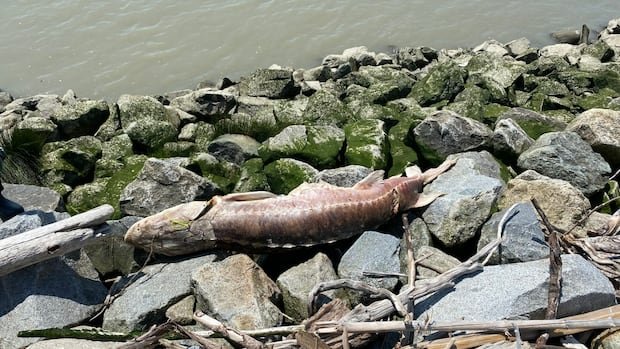In Richmond, B.C., a team of four individuals removed a sturgeon carcass from the Fraser River, part of a series of recent discoveries. This particular fish, measuring approximately 1.6 meters in length, was preserved for a research initiative initiated by the Tsawwassen First Nation. The aim of the project is to investigate the causes of sturgeon mortality and support conservation efforts. Following preservation, the sturgeon will be equipped with an electronic tracker and released back into the river.
Biologist Kelly Scott, representing the First Nation, emphasized the ancient lineage of sturgeon, dating back millions of years, expressing concerns over recent mortality events and their implications for the environment. Reports from residents along the river have highlighted an influx of sturgeon sightings, raising alarm among researchers.
The British Columbia Ministry of Land, Water, and Resource Stewardship acknowledged an apparent rise in sturgeon mortalities this year. However, evaluating the full extent of this increase has been challenging due to evolving tracking and reporting mechanisms. Since July, there have been 71 reported sturgeon deaths in B.C., with the majority occurring in the lower Fraser River, particularly in the past four weeks.
White sturgeon, known for their large size and long lifespan, hold cultural significance for First Nations communities like Tsawwassen, historically utilizing sturgeon for sustenance and ceremonial purposes. Despite the ban on sturgeon harvesting since 1994, catch-and-release practices persist in the lower Fraser River, coinciding with recent discoveries of deceased sturgeon.
Various factors contribute to sturgeon mortality, with climate change playing a significant role. Rising river temperatures, coupled with a lack of shaded areas for thermal refuge, increase stress on the fish. Collisions with propellers from large vessels pose another threat, evidenced by injuries found on deceased sturgeons. Efforts to study sturgeon mortality involve tracking carcasses with telemetry trackers to monitor their movements under different conditions.
While the ministry suspects multiple factors contributing to sturgeon deaths, including disease and warmer waters, there is no direct evidence linking recent salmon fishing activities to the mortalities. Sturgeon populations in certain rivers in British Columbia have been classified as endangered since 2006, emphasizing the need for conservation measures. Ongoing research aims to understand the underlying causes of sturgeon mortalities and assess the accuracy of reported death rates.


